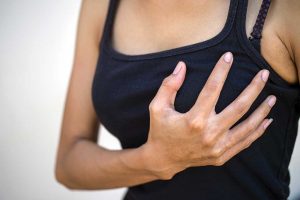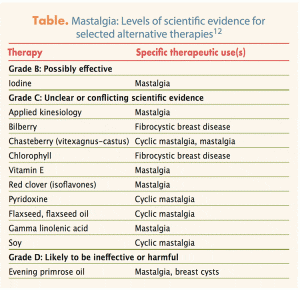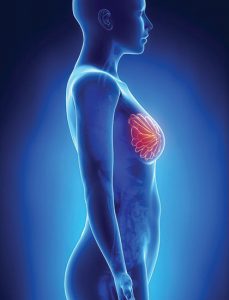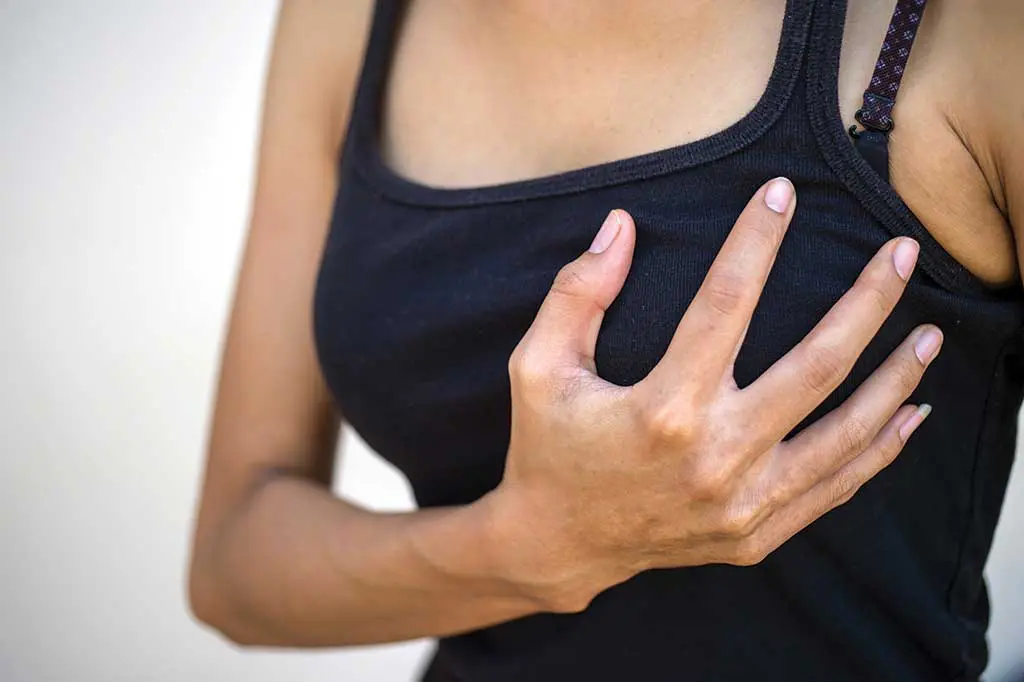By Kathryn Trotter, DNP, CNM, FNP, FAANP
Should we worry about cancer?
SM, a 38-year-old African-American woman, presents to the office with a complaint of pain in the left breast for the past 6 months. Pointing to the outer lateral breast, she describes intermittent achiness, along with a sharp stabbing pain lasting about 30 seconds if the breast is pressed or palpated. She asks whether this pain might be a symptom of breast cancer. She is also seeking pain relief because her symptoms occasionally interfere with sleep and her exercise routine. On a scale from 1-10, SM rates her overall breast pain a 3 and the sharp stabbing pain a 6. She says that the pain in her left breast does not necessarily worsen prior to menses. However, a few times a year, she reports experiencing premenstrual tenderness in both breasts. She has not noticed nipple discharge or retraction, dimpling, skin color change, nodularity, or a mass.

SM has worn underwire bras for years and occasionally wears a sports bra for workouts. She reports that sometimes wearing a bra helps with the pain. She says that one night she took over-the-counter (OTC) ibuprofen 400 mg and slept well, so she thinks that it helped ease the pain.
What additional health history information will help the NP determine the potential cause of SM’s breast pain?
SM’s health history includes only childhood asthma; she reports no surgeries, including no breast biopsies or even breast imaging. SM does not use any medications, herbal preparations, or dietary products on a regular basis. She reports no known injury to her breasts or chest area prior to pain onset. She reached menarche at age 14. Her menses had been regular until placement of the levonorgestrel intrauterine system (LNG-IUS) 9 months previously; now she has light periods every other month or so, with occasional spotting. She has a 6-year-old son who was delivered vaginally and who was breastfed for 6 months.
SM is a nonsmoker who drinks the equivalent of one cup of coffee each morning, a diet soda at lunch, and a glass of wine with dinner on the weekends. She exercises 30 minutes 2-3 days during the week and 60 minutes on Saturdays. Her family history is positive for breast cancer in her mother at age 62; her mother is now 65. No other family members have had cancer, and none have had premature cardiovascular disease.
Which differential diagnoses are you considering at this point?
Given SM’s symptoms, health history, and family history, the NP considers differentials such as mastalgia, defined as pain within the breast tissue regardless of cause; chest wall pain; and, albeit less likely, cardiac-related chest pain or breast cancer.
Which elements do you include in your physical examination?
The NP examines SM’s breasts in both seated and supine positions to avoid missing any subtle abnormalities or changes. Both breasts are moderate sized and conical; the left breast is slightly smaller than the right. No skin dimpling, color change, nipple discharge, or palpable mass is noted. With deep palpation, both outer breasts are tender, with the left breast more so. No dominant mass within the fibroglandular tissue is noted. Palpation of the cervical, supraclavicular, infraclavicular, and axillary nodes reveals no lymphadenopathy. No chest wall tenderness or mass is noted.
Which additional study or studies can help make the diagnosis?
The history and breast exam provide reassuring findings. Mastalgia is rarely a sign of breast cancer; fewer than 1% of breast cancers present as pain alone.1 However, like many women with breast pain, SM worries about the possibility of breast cancer, especially because her mother had the disease 3 years ago. Mammography can assess for nonpalpable (<1 cm-sized) breast masses, densities, or grouped calcifications, and ultrasonography (USG) can locate masses and determine if they are solid or fluid-filled.2 The standard of care, based on the NP’s assessment findings and SM’s age, is not necessarily to order breast imaging at this point, and a repeat breast exam could be offered in 2 months if the pain persists and is problematic. However, because of SM’s lingering cancer concerns, a shared decision is made to order a bilateral diagnostic mammogram.
What is the working diagnosis?
For now, the working diagnosis is noncyclic mastalgia mixed with occasional cyclic mastalgia. The family history of breast cancer in a first-degree relative is noted.
Mastalgia, also called mastodynia, is commonly classified as cyclic or noncyclic. Cyclic mastalgia typically begins in the luteal phase of the menstrual cycle and subsides after menses. It may occur when estrogen and progesterone influence the glandular structure of breast parenchyma,3 with resultant slight enlargement of the premenstrual breasts. Discomfort is most frequently reported in the outer quadrants of both breasts and is described as a dull, constant aching and tenderness with palpation. Cyclic mastalgia occurs most commonly in women aged 30-50 years and accounts for two-thirds of mastalgia cases.4
Noncyclic mastalgia is usually unilateral, constant or randomly intermittent, and often described as localized sharp or burning pain.4 Noncyclic mastalgia peaks in the fourth decade of life and resolves spontaneously in half of the women who experience it.5 Although an exact cause may not be evident, considerations include cysts, benign or malignant tumors, traumatic fat necrosis, Mondor’s disease, and stretching of Cooper’s ligaments.3 Noncyclic mastalgia may be related to the use of hormonal contraceptives or menopause hormone therapy.4 Mastalgia has also been associated with the use of digitalis, methyldopa, spironolactone, some diuretics, oxymetholone, and chlorpromazine.6
What is the NP’s management plan?
The NP reassures SM that breast pain in women is common, especially in the fourth and fifth decades of life. Reassurance is first-line treatment for mastalgia and can be effective for as many as 85% of women, with greater success achieved in patients with mild or moderate cases than in those with severe mastalgia.3 A prospective breast pain diary may be helpful if the NP is trying to differentiate cyclic mastalgia from noncyclic mastalgia. SM and the NP agree that, at this point, the diary would not likely provide additional useful information.
The progestogen-containing LNG-IUS may be a contributing factor, but breast pain is reported as an adverse reaction in only 8.5% of clinical trials with this birth control product.7 Of note, SM’s breast pain started about 3 months after she had her LNG-IUS placed. SM states that she likes the “no-worry” LNG-IUS and the lighter periods, so if this product is the culprit, she is willing to tolerate the mastalgia.
SM is advised to wear a well-fitted sports bra; she may also benefit from wearing a soft supportive bra at night if her sleep is affected. Misconceptions about bra fitting and sizing are pervasive, and many women lack basic bra knowledge. In fact, up to 70% of women wear improperly fitted bras.3 Bra variables include comfort, the bra’s ability to stay in place, discreetness, appearance under clothing, and support and breast lift. At least 80% of the support of a bra comes from the band. Readers can find tips for bra fit here and a video on common bra fit problems here SM agrees to go bra shopping.
The NP recommends that SM take an OTC non-steroidal anti-inflammatory drug (NSAID) if the discomfort lasts several hours. A study showed that diclofenac gel, a topical NSAID applied to painful areas of the breast 3 times daily for 6 months, was superior to placebo in effectuating relief of both cyclic and noncyclic mastalgia, with no side effects.8 Another study showed no difference in efficacy between oral diclofenac and topical diclofenac in treating mastalgia.9
SM asks whether she should stop drinking caffeinated beverages or take a vitamin to ease the mastalgia. The NP explains that caffeine elimination has shown only limited benefit in this regard. Likewise, no vitamin deficiency has been related to breast pain, and vitamin supplementation has not been shown to relieve mastalgia.10 However, iodine, with its antioxidant properties, may be effective. A small study showed that iodine 3,000-6,000 mcg daily for 5 months was more effective than placebo in reducing pain, tenderness, and nodularity in women with cyclic mastalgia.11 The Table lists levels of scientific evidence for selected alternative therapies, including iodine, for mastalgia and other benign breast conditions.12
For patients with more severe debilitation from mastalgia, pharmacotherapies such as danazol, tamoxifen, or bromocriptine may be considered. A meta-analysis of randomized trials found that all three of these medications offer significant relief from mastalgia.13 However, each medication has major side effects and loses efficacy after discontinuation.3,8,14 Danazol, a synthetic androgen, is the only medication approved by the FDA for the treatment of mastalgia caused by fibrocystic breast changes.14

How does the follow-up proceed in this particular case?
Two weeks later, SM’s bilateral mammogram with targeted USG to the left breast from 12 o’clock to 6 o’clock is negative for calcifications or cysts. A 6 mm x 4 mm oval hypoechoic mass in the left breast at 8 o’clock consistent with benign fibroadenoma is noted. The radiology report is BI-RADS (Breast Imaging Reporting and Data System) 3, probably benign.15 A 6-month follow-up USG to recheck this mass for stability is recommended.
The NP contacts SM to discuss the imaging results. SM is delighted that the results show no sign of cancer, and reports that her breast pain has been better since her last visit. SM has not taken any OTC NSAID products and has not yet shopped for a new bra. The NP discusses two options for further follow-up: a repeat left breast USG in 6 months or a USG-guided biopsy of the left breast mass in 2-4 weeks to verify that it is benign. The NP further explains that if the biopsy results confirm that the mass is a fibroadenoma, no excision is necessary. The plan would still be to repeat the USG in 6 months to check for stability as per American College of Surgeons guidelines.16
SM elects to proceed with the biopsy because of her maternal history of breast cancer. Although the standard of care supports watchful waiting in this case—a benign presentation—some clinicians uphold the classic triple test to evaluate any mass for cancer: Feel it, image it, biopsy it.17 The NP orders the imaging-directed biopsy within a month. Three weeks later, the NP receives the pathology report. It states: Breast, left, 8:00, USG-guided needle core biopsy: benign breast parenchyma with fibroadenomatous and fibrocystic changes, negative for malignancy. Because this benign pathology result correlates with the imaging abnormality, a 6-month USG follow-up is suggested per the routine biopsy protocol.
The NP shares with SM the biopsy results and follow-up recommendation for another USG in 6 months. The NP includes an explanation that no further treatment is necessary because the tests confirm the benign nature of the fibroadenoma. To be thorough and comprehensive, the NP uses the Breast Cancer Risk Assessment Tool to inform timing of screening breast imaging.18 Although SM has a first-degree relative who has had breast cancer and now has had a breast biopsy herself, the tool indicates that her lifetime risk for developing breast cancer is 12%—which is not significantly elevated relative to the 10% lifetime risk for a woman of the same age and race/ethnicity in the U.S. population. The NP encourages SM to undergo a screening mammogram at age 40.
Fibroadenomas are the most common benign tumors in the breast, and appear most commonly in females in their teens, 20s, or 30s. They are solid masses of both glandular breast tissue and stromal (connective) tissue.1 They are not precancerous and are not excised unless they grow quickly or are extremely painful.16 In SM’s case, the fibroadenoma is an incidental finding—she may have had it for a few years—and it is likely not the cause of her pain.
SM receives instructions to follow up sooner if her breast pain worsens or if a new mass, bloody nipple discharge, retraction, or skin color change occurs. She is advised that if the sports bra and an occasional oral NSAID are not helpful, she might consider a 1-month trial of the topical diclofenac gel 3 times daily, as needed, to see whether it provides relief. In addition, she may try warm or cold packs on the breast for symptomatic relief. SM is pleased with the news and agrees with this plan.
 Recommendations for practice
Recommendations for practice
Breast pain is common in women, with more than 70% reporting cyclic or noncyclic mastalgia at some point in their lives.19 A careful history and a complete breast and associated lymphatic examination are key to evaluation of mastalgia. Once pathology is ruled out, supportive measures, including proper bra fit, are the mainstays of treatment. Nonpharmacologic and alternative therapies can be helpful in the treatment of mastalgia, although evidence is limited.
Kathryn Trotter is Associate Professor and Lead Faculty, Women’s Health Nurse Practitioner Major, at Duke University School of Nursing in Durham, North Carolina. The author states that she does not have a financial interest in or other relationship with any commercial product named in this article.
References
1. American Cancer Society. Breast Cancer Facts & Figures 2015-2016. 2016. cancer.org/research/cancerfactsstatistics/breast-cancer-facts-figures
2. Friedewald SM, Rafferty EA, Rose SL, et al. Breast cancer screening using tomosynthesis in combination with digital mammography. JAMA. 2014;311(24):2499-2507.
3. Kataria K, Dhar A, Srivastava A, et al. A systematic review of current understanding and management of mastalgia. Indian J Surg. 2014;76(3):217-222.
4. Collins LC, Schnitt SJ. Pathology of benign breast disorders. In: Harris JR, Lippman ME, Morrow MO, Osborne CK, eds, Diseases of the Breast. 5th ed. Philadelphia, PA: Wolters Kluwer Health; 2014.
5. Ferrara A. Benign breast disease. Radiol Technol. 2011;82(5):447M-462M.
6. National Breast Cancer Foundation, Inc. Breast Pain. 2016.
7. Mirena Prescribing Information. Whippany, NJ: Bayer HealthCare Pharmaceuticals Inc.; 2015.
8. Colak T, Ipek T, Kanik A, et al. Efficacy of topical nonsteroidal antiinflammatory drugs in mastalgia treatment. J Am Coll Surg. 2003;196(4):525-530.
9. Zafar A, Rehman A. Topical diclofenac versus oral diclofenac in the treatment of mastalgia—a randomized clinical trial. Rawal Med J. 2013;38(4):371-377.
10. Amin AL, Purdy AC, Mattingly JD, et al. Benign breast disease. Surg Clin North Am. 2013;93(2):299-308.
11. Anguiano B, Aceves C. Iodine in mammary and prostate pathologies. Curr Chem Biol. 2011;5(3):177-182.
12. Jellin JM, Gregory P, Batz F, et al. Natural Medicines Comprehensive Database. 3rd ed. Stockton, CA: Therapeutic Research; 2000.
13. Srivastava A, Mansel RE, Arvind N, et al. Evidence-based management of mastalgia: a meta-analysis of randomised trials. Breast. 2007;16(5):503-512.
14. Iddon J, Dixon JM. Mastalgia. BMJ. 2013;347:f3288.
15. Balleyguier C, Ayadi S, Van Nguyen K, et al. BIRADS™ classification in mammography. Eur J Radiol. 2007;61(12):192-194.
16. Hubbard JL, Cagle K, Davis JW, et al. Criteria for excision of suspected fibroadenomas of the breast. Am J Surg. 2015;209(2):297-301.
17. Irwig L, Macaskill P, Houssami N. Evidence relevant to the investigation of breast symptoms: the triple test. Breast. 2002;11(3):215-220.
18. National Cancer Institute. Breast Cancer Risk Assessment Tool. n.d.
19. Smith RL, Pruthi S, Fitzpatrick LA. Evaluation and management of breast pain. Mayo Clin Proc. 2004;79(3):353-372.

